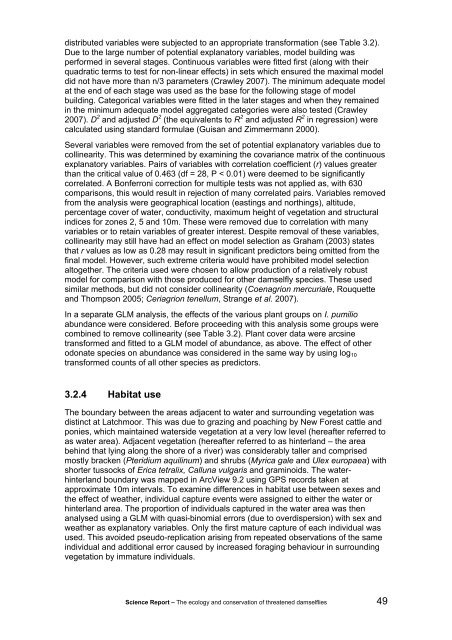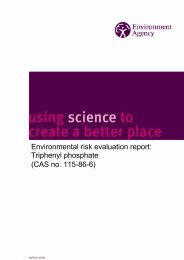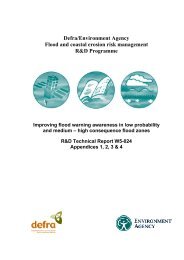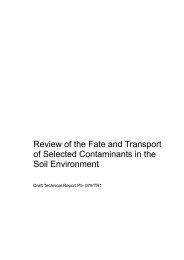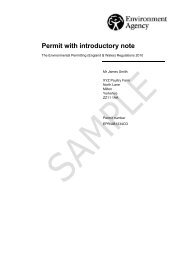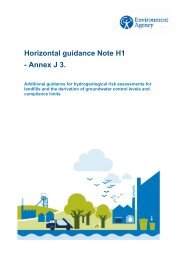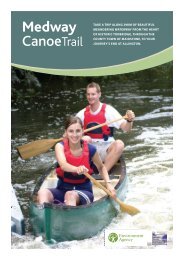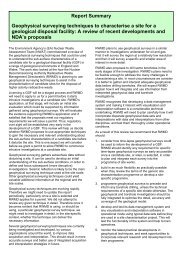The ecology and conservation of threatened damselflies
The ecology and conservation of threatened damselflies
The ecology and conservation of threatened damselflies
Create successful ePaper yourself
Turn your PDF publications into a flip-book with our unique Google optimized e-Paper software.
distributed variables were subjected to an appropriate transformation (see Table 3.2).<br />
Due to the large number <strong>of</strong> potential explanatory variables, model building was<br />
performed in several stages. Continuous variables were fitted first (along with their<br />
quadratic terms to test for non-linear effects) in sets which ensured the maximal model<br />
did not have more than n/3 parameters (Crawley 2007). <strong>The</strong> minimum adequate model<br />
at the end <strong>of</strong> each stage was used as the base for the following stage <strong>of</strong> model<br />
building. Categorical variables were fitted in the later stages <strong>and</strong> when they remained<br />
in the minimum adequate model aggregated categories were also tested (Crawley<br />
2007). D 2 <strong>and</strong> adjusted D 2 (the equivalents to R 2 <strong>and</strong> adjusted R 2 in regression) were<br />
calculated using st<strong>and</strong>ard formulae (Guisan <strong>and</strong> Zimmermann 2000).<br />
Several variables were removed from the set <strong>of</strong> potential explanatory variables due to<br />
collinearity. This was determined by examining the covariance matrix <strong>of</strong> the continuous<br />
explanatory variables. Pairs <strong>of</strong> variables with correlation coefficient (r) values greater<br />
than the critical value <strong>of</strong> 0.463 (df = 28, P < 0.01) were deemed to be significantly<br />
correlated. A Bonferroni correction for multiple tests was not applied as, with 630<br />
comparisons, this would result in rejection <strong>of</strong> many correlated pairs. Variables removed<br />
from the analysis were geographical location (eastings <strong>and</strong> northings), altitude,<br />
percentage cover <strong>of</strong> water, conductivity, maximum height <strong>of</strong> vegetation <strong>and</strong> structural<br />
indices for zones 2, 5 <strong>and</strong> 10m. <strong>The</strong>se were removed due to correlation with many<br />
variables or to retain variables <strong>of</strong> greater interest. Despite removal <strong>of</strong> these variables,<br />
collinearity may still have had an effect on model selection as Graham (2003) states<br />
that r values as low as 0.28 may result in significant predictors being omitted from the<br />
final model. However, such extreme criteria would have prohibited model selection<br />
altogether. <strong>The</strong> criteria used were chosen to allow production <strong>of</strong> a relatively robust<br />
model for comparison with those produced for other damselfly species. <strong>The</strong>se used<br />
similar methods, but did not consider collinearity (Coenagrion mercuriale, Rouquette<br />
<strong>and</strong> Thompson 2005; Ceriagrion tenellum, Strange et al. 2007).<br />
In a separate GLM analysis, the effects <strong>of</strong> the various plant groups on I. pumilio<br />
abundance were considered. Before proceeding with this analysis some groups were<br />
combined to remove collinearity (see Table 3.2). Plant cover data were arcsine<br />
transformed <strong>and</strong> fitted to a GLM model <strong>of</strong> abundance, as above. <strong>The</strong> effect <strong>of</strong> other<br />
odonate species on abundance was considered in the same way by using log10<br />
transformed counts <strong>of</strong> all other species as predictors.<br />
3.2.4 Habitat use<br />
<strong>The</strong> boundary between the areas adjacent to water <strong>and</strong> surrounding vegetation was<br />
distinct at Latchmoor. This was due to grazing <strong>and</strong> poaching by New Forest cattle <strong>and</strong><br />
ponies, which maintained waterside vegetation at a very low level (hereafter referred to<br />
as water area). Adjacent vegetation (hereafter referred to as hinterl<strong>and</strong> – the area<br />
behind that lying along the shore <strong>of</strong> a river) was considerably taller <strong>and</strong> comprised<br />
mostly bracken (Pteridium aquilinum) <strong>and</strong> shrubs (Myrica gale <strong>and</strong> Ulex europaea) with<br />
shorter tussocks <strong>of</strong> Erica tetralix, Calluna vulgaris <strong>and</strong> graminoids. <strong>The</strong> waterhinterl<strong>and</strong><br />
boundary was mapped in ArcView 9.2 using GPS records taken at<br />
approximate 10m intervals. To examine differences in habitat use between sexes <strong>and</strong><br />
the effect <strong>of</strong> weather, individual capture events were assigned to either the water or<br />
hinterl<strong>and</strong> area. <strong>The</strong> proportion <strong>of</strong> individuals captured in the water area was then<br />
analysed using a GLM with quasi-binomial errors (due to overdispersion) with sex <strong>and</strong><br />
weather as explanatory variables. Only the first mature capture <strong>of</strong> each individual was<br />
used. This avoided pseudo-replication arising from repeated observations <strong>of</strong> the same<br />
individual <strong>and</strong> additional error caused by increased foraging behaviour in surrounding<br />
vegetation by immature individuals.<br />
Science Report – <strong>The</strong> <strong>ecology</strong> <strong>and</strong> <strong>conservation</strong> <strong>of</strong> <strong>threatened</strong> <strong>damselflies</strong> 49


